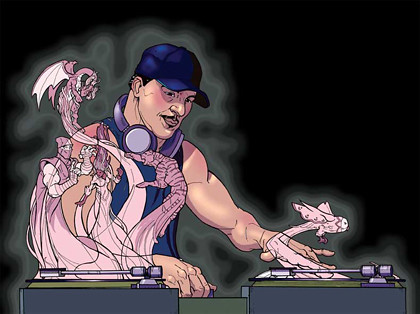Mixmaster Mike
By Charlie Russo
Deep in the annals of hip-hop history, the origin of the deejay’s scratch is filed under the year 1975 and reads like this: “Eleven years old and practicing deejaying on his older brother’s turntables, Theodore Livingston grabbed for the record as his mom shouted at him to turn the music down. Hearing an odd scratching sound through his headphones as the vinyl moved in his grasp, Theodore knew he was on to something.” Livingston eventually became known as Grandwizard Theodore and was credited as the inventor of both the scratch and needle drop techniques.
Thirty years later, hip-hop has begun to outsell rock music in America, and early forefathers such as Grandwizard Theordore have been succeeded by a lengthy list of turntable talent: DJ Premier, Q-Bert, Z-Trip, Cut Chemist...and of course, Mixmaster Mike. These names may not necessarily be classified as early inventors, but are sure to be remembered as major pioneers all the same.
That said, Mixmaster Mike may very well be remembered as the John Coltrane of turntablism: a musician who caused a quantum leap in the evolution of an already developing art form.
As a three-time DMC world deejay champion as well as the frequently fourth Beastie Boy, Mixmaster Mike cites the road back to the founders as the way for hip-hop to move ahead. ”hip-hop is in a state of re-evaluation,” he explains, ”People need to look back to how hip-hop formed in order to move it forward. I always revert to Grandmaster Flash, The Cold Crush Brothers, and—of all inspirations—to Grandwizard Theodore... back to when hip-hop was a lot of fun.”
It’s not surprising to hear the Mixmaster place emphasis on the old school’s upbeat brand of hip-hop. Anyone who has seen Mike perform knows that amongst all the scratch & whir wizardry, the cut-ups of an eclectic music library, and the barrage of beats... the Mixmaster just knows how to bring a party.
It’s a fact that Bay Area residents were aware of Mike long before he signed on with the Beastie Boys. Though he no longer lives in Northern California, it was during his time here in the foggy Bay that Mike truly became the Mixmaster.
“The Bay Area is and has always been underground,” Mike says in assessing the area’s place in hip-hop culture. “I know my boys Q-Bert, Shortkut and those heads are definitely holding it down,” he adds, “so I’m sure that I left the Bay Area in good hands.”
No arguments there. When it comes to his cohorts around the Bay, good hands are not hard to come by. After the string of DMC championships in the mid-’90s, Mike had joined forces with Yoga Frog, Q-Bert, Shortkut, and D-Styles to form the Invisible Skratch Picklez; the deejay wrecking crew that put the Bay Area in the forefront of the ever-expanding art of turntablism.
Though the Picklez have since disbanded, the Mixmaster still has the itch to keep on scratchin’. In addition to his key role on the latest Beastie Boys’ release To the Five Boroughs, Mike recently unleashed his own mixmonster, Bangzilla.
“This album was like 3 years in the process,” he explains. “I made it in different parts while in many different places - on tour, on planes - and then I tied it all together.”
Bangzilla is certainly an altered beast, showcasing a wide range of beats and scratching techniques, as well as samples that evaporate just as you’re on the verge of recognizing them. On a more subtle level, the dizzying collision of soundscapes seems to have an underlying theme, often coming across like the soundtrack to battles in a galaxy far, far away. “I had 14 tracks to work with and to think about different ways to manipulate music,” Mike says. “I never went about making this album as a concept album... it just came out that way.”
The balance between solo projects like Bangzilla and his role as the Beasties’ beat boy is a particular distinction, one that Mike characterizes as totally different worlds. “It’s like split personalities going on,” he says. “As a solo artist versus being in the group and adding my take on the songs.”
More than just in the studio, it is a contrast that Mike notices considerably in the live arena. ”Doing solo shows you have to hold up your audience,” he explains, “it takes a lot of endurance to do an hour-long show with non-stop tricks. Scratching with the boys I can choose my spots and give the show a flow.”
And though he may no longer be an official resident, the Mixmaster continues to reflect the Bay Areas contribution to hip-hop as a whole: rarely center stage, but still providing the hottest moments of the night.



<< Home